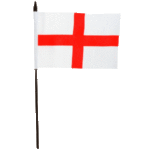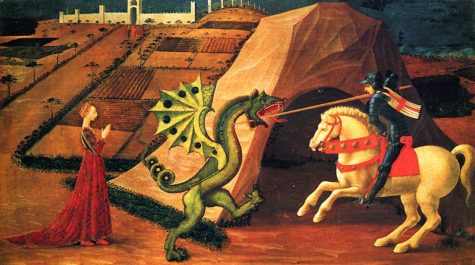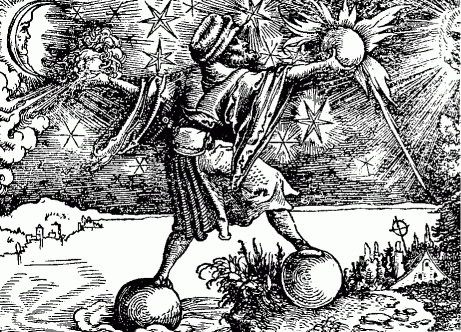Daily Archives: April 18, 2017
Saint George’s Day is celebrated on April 23, the traditionally accepted date of the saint’s death in AD 303. For those Eastern Orthodox Churches which use the Julian calendar, this date currently falls on the day of 6 May of the Gregorian calendar. In Turkish culture the day is known as Hıdırellez or Xıdır Nəbi and is symbolic of spring renewal.
It is also believed to be a magical day when all evil spells can be broken. It was believed that the saint helps the crops to grow and blesses the morning dew, so early in the morning they walked in the pastures and meadows and collected dew, washed their face, hands and feet in it for good luck and even in some rural parts of Bulgaria it was a custom to roll in it naked.
In Romania, people celebrate St. George – ‘Sfantul Gheorghe’ – and in certain regions, including Bucovina, people will still plant cut willow branches in freshly cut earth and place them at the entrances to their homes.
Many Christian denominations in Syria celebrate St George’s Day, especially in the Homs Governorate. They do this by dressing small children as dragons and chasing them through the streets whilst beating them with clubs and batons. It is a very special time of year, after the beatings folks will enjoy a sit down dinner and dancing.
Saint George’s Day is the feast day of Saint George as celebrated by various Christian Churches and by the several nations, kingdoms, countries, and cities of which Saint George is the patron saint.
Since Easter often falls close to Saint George’s Day, the church celebration of the feast may be moved to accommodate the Easter Festivities. Similarly, the Eastern Orthodox celebration of the feast moves accordingly to the first Monday after Easter or, as it is sometimes called, to the Monday of Bright Week.
Some Orthodox Churches have additional feasts dedicated to St George. The country of Georgia celebrates the feast of St. George on April 23, and, more prominently, November 10 (Julian calendar), which currently fall on May 6 and November 23 (Gregorian calendar), respectively.
 St George’s Day was a major feast and national holiday in England on a par with Christmas from the early 15th century. The Cross of St. George was flown in 1497 by John Cabot on his voyage to discover Newfoundland and later by Sir Francis Drake and Sir Walter Raleigh. In 1620 it was the flag that was flown on the foremast of the Mayflower when the Pilgrim Fathers arrived in Plymouth, Massachusetts.
St George’s Day was a major feast and national holiday in England on a par with Christmas from the early 15th century. The Cross of St. George was flown in 1497 by John Cabot on his voyage to discover Newfoundland and later by Sir Francis Drake and Sir Walter Raleigh. In 1620 it was the flag that was flown on the foremast of the Mayflower when the Pilgrim Fathers arrived in Plymouth, Massachusetts.
The tradition of celebration St George’s day had waned by the end of the 18th century after the union of England and Scotland. Nevertheless, the link with St. George continues today, for example Salisbury holds an annual St. George’s Day pageant, the origins of which are believed to go back to the 13th century. In recent years the popularity of St. George’s Day appears to be increasing gradually. Today, St. George’s day may be celebrated with anything English including morris dancing and Punch and Judy shows.
A traditional custom on St George’s day is to wear a red rose in one’s lapel, though this is no longer widely practiced. Another custom is to fly or adorn the St George’s Cross flag in some way: pubs in particular can be seen on April 23 festooned with garlands of St George’s crosses. It is customary for the hymn “Jerusalem” to be sung in cathedrals, churches and chapels on St George’s Day, or on the Sunday closest to it. Traditional English food and drink may be consumed.
In the Valencian city of Alcoi, Saint George’s Day is commemorated as a thanksgiving celebration for the proclaimed aid the Saint provided to the Christian troops fighting the Muslims in the siege of the city. Its citizens commemorate the day with a festivity in which thousands of people parade in medieval costumes, forming two “armies” of Moors and Christians and re-enacting the siege that gave the city to the Christians.
The Serbian St George’s Day is called Đurđevdan and is celebrated on 6 May every year, as the Serbian Orthodox Church uses the Julian, Old Style calendar. Đurđevdan is also celebrated by both Orthodox and Muslim Romani and Muslim Gorani. Đurđevdan is celebrated, especially, in the areas of Raška in Serbia, and is marked by morning picnics, music, and folk dances.
In Russia, St George’s Day (Гергьовден, Gergyovden) is a public holiday that takes place on 6 May each year. It is possibly the most celebrated name day in the country. A common ritual is to prepare and eat a whole lamb, which is an ancient practice possibly related to Slavic pagan sacrificial traditions and the fact that St George is the patron saint of shepherds.
A Protective Blessing Ritual for Saint George’s Day:
In many communities, Saint George’s Day was the day animals were lead out into the field, thus protective, blessing rituals abound. Here’s one:
- Lead all healthy animals three times around the perimeter of their field, barn or home, always in a sunwise direction.
- The person leading the parade carries a lit torch.
- The person bringing up the rear holds an open padlock in one hand, the key in the other hand.
- After the third round, the animals are lead back into the barn.
- Turn the key in the lock.
- Throw the key into a river or stream, while preserving the now permanently locked padlock.
Dragons and Dragon’s Blood:
St. George is credited with having slain a fearsome dragon to save the life of a virgin. The Dragon means different things to different peoples. In some medieval traditions it is linked with the devil or Satan, hence the carvings and windows depicting St George, (or sometimes St Michael), slaying one.
But the Dragon has far older associations in which it represents the life force of the land. In the Craft we often refer to the Earth Dragon, a great coiled beast who sleeps within the Earth and who can be called upon to work healing for the planet. The Earth Dragon is often invoked in cases of potential ecological danger. King Arthur’s father was named Uther Pendragon, and it is thought that his name shows that he was a defender of the land. The Dragon is a symbol of Wales and appears on the country’s flag.
Dragon’s blood is not the blood of some luckless lizard, but the resin of the palm calimus draco. Magically it is used for spells of protection, exorcism and sexual potency. Added to incenses it increases their potency and drives away all negativity. On its own Dragon’s blood can be burnt at an open window to secure a lover’s return, and a piece of the resin placed under the mattress is said to cure impotence. In the past Dragon’s Blood was used medicinally to cure diarrhoea, dysentery and even syphilis. Like many other resins it is also used to stop bleeding wounds.
Sources:
Notes: I am assuming that this counting of the days begins and ends with the new moon. Notice that there are 29 days listed even though it only takes the moon 27.3 days to orbit the earth. I also found the juxtaposition of the Major Arcana of the Tarot with Old Testament happenings, and the Goddess Hecate (see day 27), an interesting mix.
1. The Juggler, or Magus— The first day of the moon is that of the creation of the moon itself. This day is consecrated to mental enterprises, and should be favorable for opportune innovations.
2. Pope Joan, or Occult Science — This day is propitious to revelations, initiations, and great discoveries of science.
3. The Celestial Mother, or Empress— The third day was that of man’s creation. So is the moon called the MOTHER in Kabbalah, when it is represented in association with the number three. This day is favorable to generation, and generally to all productions, whether of body or mind.
4. The Emperor, or Ruler— The fourth day is baleful; it was that of the birth of Cain; but it is favorable to unjust and tyrannical enterprises.
5. The Pope, or Hierophant— The fifth day is fortunate; it was that of the birth of Abel.
6. The Lover, or Liberty— The sixth is a day of pride; it was that of the birth of Lamech, who said unto his wives; “I have slain a man to my wounding, and a young man to my hurt. If Cain shall be avenged sevenfold, truly Lamech seventy and sevenfold.” This day is propitious for conspiracies and rebellions.
7. The Chariot— On the seventh day, birth of Hebron, who gave his name to the first of the seven sacred cities of Israel. A day of religion, prayers and success.
8. Justice— Murder of Abel. Day of expiation.
9. The Old Man, or Hermit— Birth of Methucelah. Day of blessing for children.
10. Ezekiel’s Wheel of Fortune— Birth of Nebuchadnezzar. Reign of the Beast. Fatal day.
11. Strength— Birth of Noah. Visions on this day are deceitful, but it is one of health and long life for children born on it.
12. The Victim, or Hanged Man— Birth of Samuel, Prophetic and kabbalistic day, favorable to the fulfilment of the great work.
13. Death— Birthday of Canaan. the accursed son of Cham. Baleful day and fatal number.
14. The Angel of Temperance— Blessing of Noah on the fourteenth day of the moon. This day is governed by the angel Cassiel of the hierarchy of Uriel.
15. Typhon, or the Devil— Birth of Ishmael. Day of reprobation and exile.
16. The Blasted Tower— Birthday of Jacob and Esau; the day also of Jacob’s predestination, to Esau’s ruin.
17. The Glittering Star— Fire from heaven burns Sodom and Gomorrah. Day of salvation for the good, and ruin for the wicked; on a Saturday dangerous. It is under the dominion of the Scorpion.
18. The Moon— Birth of Isaac. Wife’s triumph. Day of conjugal affection and good hope.
19. The Sun— Birth of Pharaoh. A beneficent or fatal day for the great of earth, according to the different merits of the great.
20. The Judgment— Birth of Jesus, the instrument of God’s judgment. Propitious for divine revelations.
21. The World— Birth of Saul, material royalty. Danger to mind and reason.
22. Influence of Saturn— Birth of Job. Day of trial and suffering.
23. Influence of Venus— Birth of Benjamin. Day of Preference and tenderness.
24. Influence of Jupiter— Birth of Japhet.
25. Influence of Mercury— Tenth plague of Egypt.
26. Influence of Mars— Deliverance of the Israelites, and passage of the Red Sea.
27. Influence of Diana, or Hecate— Splendid victory achieved by Judas Maccabeus.
28. Influence of the Sun— Samson carries off the gates of Gaza. Day of strength and deliverance.
29. The Fool of the Tarot— Day of failure and miscarriage in all things.
Found in:
Encyclopaedia of Superstitions, Folklore, and the Occult Sciences of the World








